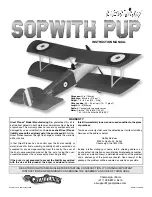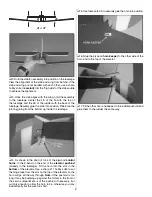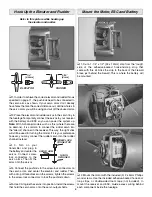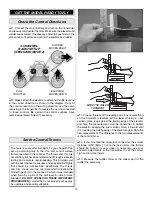
MOTOR SAFETY PRECAUTIONS
Failure to follow these safety precautions may result
in severe injury to yourself and others.
• Use safety glasses when starting or running motors.
• Do not run the motor in an area of loose gravel or sand; the
propeller may throw such material in your face or eyes.
• Keep your face and body as well as all spectators away
from the plane of rotation of the propeller as you start and
run the motor.
• Keep loose clothing, shirt sleeves, ties, scarfs, long hair or
loose objects such as pencils or screwdrivers that may fall
out of shirt or jacket pockets away from the prop.
FLYING
Ground Check and Range Check
When you get to your fl ying site ground check the operational
range of your radio before the fi rst fl ight following the
manufacturer’s instructions that came with your radio. This
should be done both with the motor off and with the motor
running at various speeds. If the motor or control surfaces do
not respond correctly or move erratically without command,
do not fl y!
Find and correct the problem fi rst. Look for loose
servo connections or broken or loose motor or battery wires.
Flight
The SlowFly Sopwith Pup is capable of “ROG” (rise off
ground) takeoffs as long as the surface is smooth (as any
indoor venue would be), but if fl ying outdoors over grass
a hand-launch will be required. To hand-launch, hold the
model by the fuselage just behind the cockpit and advance
the throttle. Give the model a gentle push with a slightly
nose-up attitude and let go. Allow the model to momentarily
sink while it gains fl ying speed and work the controls to keep
the wings and fuselage level. Once, after just a second or
two, the model has gained suffi cient fl ying speed, establish
a gentle climb.
Once at “altitude” the fi rst priority will be to trim the elevator
and rudder so the model fl ies straight-and-level. Once the
model has been trimmed continue to fl y around for a few
minutes getting used to how the model responds. If using
dual rates, switch between the rates to see how the model
responds. At a safe altitude, cut the power and see how the
model reacts. Make sure there will be enough elevator to
make a landing fl air.
After fl ying around for a few minutes make a few landing
approaches. Once you have an approach you “like,” simply
allow the model to land, applying elevator to execute the fl air.
If there is enough battery power you could perform another
takeoff and continue to fl y around, or go back and change
the battery (or recharge the battery you are using).
One fi nal note about fl ying your model. Have a goal or fl ight
plan in mind for
every
fl ight. This can be learning a new
maneuver(s), improving a maneuver(s) you already know,
or learning how the model behaves in certain conditions
(such as on high or low rates). This is not necessarily to
improve your skills (
though it is never a bad idea!)
, but more
importantly so you do not surprise yourself by impulsively
attempting a maneuver and suddenly fi nding that you’ve run
out of time, altitude or airspeed. Every maneuver should be
deliberate, not impulsive. For example, if you’re going to do a
loop, check your altitude, mind the wind direction (anticipating
rudder corrections that will be required to maintain heading),
remember to throttle back at the top, and make certain you
are on the desired rates (high/low rates). A fl ight plan greatly
reduces the chances of crashing your model just because of
poor planning and impulsive moves.
Remember to think.
Have a ball! But always stay in control
and fl y in a safe manner
GOOD LUCK AND GREAT FLYING!
Please fi ll in this identifi cation tag
and place inside your model.






























